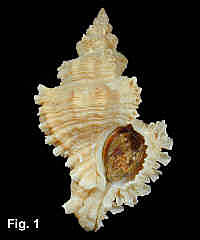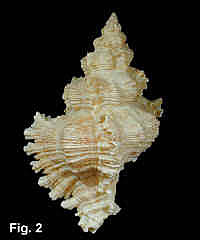|
|
|
|
Chicoreus denudatus (Perry, 1811) Description: Shell with rounded whorls with three varices per whorl. Each varix with about six low, open fronds on body whorl and three on anterior canal; the two upper and two lower fronds interconnected by webbing. Whorls coarsely spirally ribbed, with one or two prominent nodules between varices on shoulder. Colour uniformly fawn, brown, yellow or orange. Size: Up to 60 mm in length. Distribution : Endemic to Australia; Rockhampton, Qld to Westernport, Vic, and northern Tas. Specimens are known from SA, but these are probably fossil as the species appears to be extinct there. Habitat : Occurs intertidally among rocks in muddy environments, and down to about 100 m. Common subtidally. Comparison : C. denudatus has much shorter spines than C. damicornis; it occurs intertidally, whereas C. damicornis is found deeper than 35 m. Good specimens of the two species can be separated on spine length, and the details of webbing between the spines, but it is almost impossible to confidently identify worn specimens. Beach collected shells are most likely to be C. denudatus. Chicoreus territus is occasionally found in northern NSW, with a few specimens known as far south as Sydney; shells have 5 or 6 open recurved spines per varix, all interconnected with webbing, but short spined specimens occur and are very similar to C. denudatus. Synonyms : Torvamurex denudatus immunitus Iredale, 1936 is a smaller, narrower shell but otherwise agrees with the typical form. Torvamurex extraneus Iredale, 1936 was applied to a specimen with unusually well developed fronds. Remarks : Coleman (1975) states that food is usually restricted to bivalves, including oysters, mussels and scallops. He obtained clean specimens from 3 to 20 m depth, covered with an orange sponge. Fig. 1,2: (DLB unregistered) |
|

